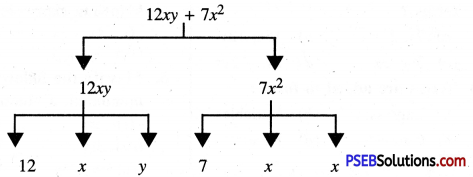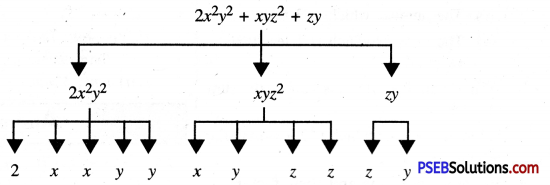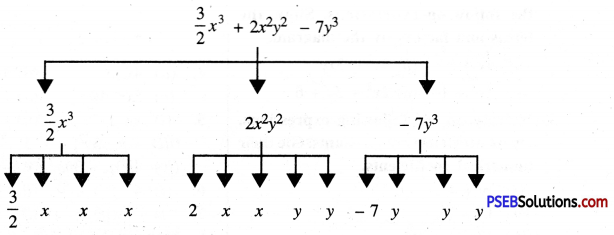Punjab State Board PSEB 7th Class Hindi Book Solutions Chapter 4 कार्निवल का चक्कर Textbook Exercise Questions and Answers.
PSEB Solutions for Class 7 Hindi Chapter 4 कार्निवल का चक्कर
Hindi Guide for Class 7 PSEB कार्निवल का चक्कर Textbook Questions and Answers
(क) भाषा-बोध
1. शब्दार्थ
कार्निवल = मेला, आनन्दोत्सव
नवरत्न = नौ रत्नों से बनी वस्तु
स्पर्श = छूना
नवग्रह = नौ ग्रह-सूर्य, चन्द्रमा, मंगल, बुध, शुक्र, बृहस्पति, शनि, राहु, केतु
तोड़ = बचाव
पगार = वेतन
तरकारी = सब्जी
पुनर्जीवित = दुबारा जीवित करना
मरुस्थल का जहाज़ = ऊँट
शुल्क = फीस
ड्राइव = गोता लगाना
सैम्पल – नमूना
क्रैश – दुर्घटनाग्रस्त
पेय = पीने का पदार्थ
विस्फारित = अच्छी तरह से खोला हुआ
हूटर = चेतावनी सूचक, ध्वनि यंत्र
कैमल राइडिंग = ऊँट की सवारी
ऊहापोह = दुविधा
उधेड़बुन = सोच-विचार
2. लिंग बदलो
लाला = ललाइन
बाबू = ……………
नाई = …………..
पंडित = …………..
चौधरी = …………..
गुरु = ……………
माली = …………..
धोबी = …………..
सुनार = ………….
ग्वाला = ………….
नौकर = ………….
उत्तर:
लाला = ललाइन
बाबू = बबुआइन
नाई = नाइन
पंडित = पंडिताइन
चौधरी = चौधरानी
गुरु = गुरुआइन
माली = मालिन
धोबी = धोबिन
सुनार = सुनारिन
ग्वाला = ग्वालिन
नौकर = नौकरानी

3. इन शब्दों के विपरीत अर्थ वाले शब्द लिखें:
विदेशी = ………………..
विद्वान = ………………..
महंगा = ………………..
स्वाद = ………………..
प्रवेश = ………………..
नई = …………………
उत्तर:
शब्द विपरीत शब्द
विदेशी = देशी
विद्वान = मुर्ख
महंगा = सस्ता
प्रवेश = निकास
नई = पुरानी
4. इन शब्दों के शुद्ध रूप लिखें:
इस्कूटर = ……………
सन्नाटा = …………..
पटरोल = …………..
कारनीवल = ……………..
विसफारित = …………….
जूनिवरसिटी = …………….
कमकपी = ……………
टिककीयाँ = ……………..
बुद्दी = ……………..
उत्तर:
अशुद्ध शुद्ध
इस्कूटर = स्कूटर
सन्नाटा = सन्नाटा
पटरोल = पैट्रोल
कारनीवल = कार्निवल
विसफारित = विस्फारित
जूनिवरसिटी = यूनिवर्सिटी
कमकपी = कँपकँपी
टिककीयाँ = टिक्कियाँ
बुद्दी = बुद्धि
5. इन शब्दों के पर्यायवाची शब्द लिखें:
पगार = …………….
आसमान = ……………..
आग = ……………
पवन = …………….
घोड़ा = ………………
उत्तर:
शब्द पर्यायवाची शब्द
पगार = वेतन, पारिश्रमिक, तनख्वाह
आसमान = गगन, आकाश, नभ
आग = पावक, अनल, बह्नि
पवन = समीर, वायु, हवा
घोड़ा = अश्व, तुरंग, हय।
6. (क) निम्नलिखित मुहावरों, लोकोक्तियों के अर्थ लिखकर वाक्यों में प्रयोग करें
उकता जाना, हाथ पसारना, अक्ल घास चरने जाना, टेढ़ी खीर होना, कान पर जूं न रेंगना, आँखें तरेरना, दुम दबा कर भागना, हवा से बातें करना, चेहरे पर चमक आना।।
उत्तर:
उकता जाना (तंग होना) – मनजीत की फालतू बातें सुन-सुनकर सिमरन उकता गई।
हाथ पसारना (मांगना) – कौशल्या के पास इतना कुछ है फिर भी भाई के आगे हमेशा हाथ पसारती रहती है।
अक्ल घास चरने जाना (समझ नहीं आना) – हरदीप को चाहे कितना समझा लो, वह नहीं समझेगा क्योंकि उसकी तो अक्ल घास चरने गई है।
टेढ़ी खीर होना (बहुत कठिन कार्य) – एवरेस्ट की चोटी पर चढ़ना कोई बच्चों का खेल नहीं, टेढी खीर है।
कान पर जूं न रेंगना (कोई असर न होना) – रेहाना को कितना भी डाँट लो उस के तो कान पर जूं भी नहीं रेंगती।
आँखें तरेरना (क्रोध से देखना) – कक्षा में शोर सुन कर जैसे ही अध्यापक ने आँखें तरेरी कि कक्षा में सन्नाटा छा गया।
दुम दबा कर भागना (चुपचाप चले जाना) – मुख्याध्यापक को आते देखकर राम और श्याम आपस में लड़ना छोड़ दुम दबा कर भाग गए।
हवा से बातें करना (तेज़ भागना) – राणा प्रताप का घोड़ा चेतक संकेत मिलते ही हवा से बातें करने लगता था।
चेहरे पर चमक आना (प्रसन्न होना)-अपने नाम लॉटरी निकलने का समाचार सुनते ही सुरेन्द्र के चेहरे पर चमक आ गई।
(ख) विचार-बोध
1. इन प्रश्नों के उत्तर एक या दो वाक्यों में लिखें:
प्रश्न 1.
लेखक बच्चों को कहाँ घुमाने ले गए ?
उत्तर:
लेखक बच्चों को कार्निवल घमाने ले गए।
प्रश्न 2.
लेखक ने अपने आप को अमीर क्यों समझा ?
उत्तर:
लेखक ने अपने आप को अमीर इसलिए समझा क्योंकि उसे वेतन मिले दोचार दिन हुए थे तथा अभी तक उसने किसी का उधार नहीं चुकाया था।
प्रश्न 3.
कार्निवल घूमना टेढ़ी खीर क्यों था ?
उत्तर:
कार्निवल घूमना टेढ़ी खीर इसलिए था क्योंकि वहाँ बहुत रुपए खर्च हो जाते हैं तथा वह महंगा स्थान होता है।
प्रश्न 4.
बच्चों ने अपने पिता के आगे क्या-क्या फ़रमाइशें रखीं ?
उत्तर:
बच्चों ने पिता को बर्गर, गोलगप्पे खिलाने, कोल्ड ड्रिंक पिलाने, टिक्की खिलाने और झूला झुलवाने के लिए कहा।
प्रश्न 5.
गोलगप्पे खाते हुए लेखक का श्वास क्या सुनकर अटक गया ?
उत्तर:
गोलगप्पे खाते हुए लेखक का श्वास यह सुनकर अटक गया कि एक गोलगप्पे का मूल्य पाँच रुपये है।
प्रश्न 6.
टिक्की खाते हुए लेखक को कहाँ की याद आ गई ?
उत्तर:
टिक्की खाते हुए लेखक को नयी-नयी शादी पर कचौरी की खायी टिक्कियाँ याद आ गईं।
2. इन प्रश्नों के उत्तर चार-पाँच वाक्यों में लिखें:
प्रश्न 1.
झूले वाली घटना को अपने शब्दों में लिखें।
उत्तर:
बच्चों ने झूला झूलने के लिए कहा तो लेखक तुरन्त अकड़ते हुए झूले वाले के पास रौब से पाँच टिकट देने के लिए कहा। जब झूले वाले ने पाँच टिकट के चार सौ रुपये मांगे तो वह धम्म से नीचे गिर गया। उसके चेहरे पर हवाइयाँ उड़ने लगी और सिर चक्कर खाने लगा। आस-पास के लोगों ने कहा दौरा पड़ गया, कोई बोला मिर्गी है चप्पल-जूता सुंधाओ तो किसी ने कहा कि हृदयघात लगता है। इस पर लेखक ने उन्हें कांपते हाथों से अपने परिवार की ओर संकेत किया। तब सब लोग उसे उसके बच्चों के पास पटक गए।

प्रश्न 2.
इस पाठ में लेखक ने महंगाई पर व्यंग्य के बाण छोड़े हैं। कोई एक उदाहरण लिखें।
उत्तर:
लेखक बच्चों को घुमाने कार्निवल ले गया था पर उन्हें वहाँ कोल्ड ड्रिंक आदि नहीं पिलवा सका क्योंकि वहाँ वे सब बहुत महँगे थे। वह बच्चों को बहलाने के लिए कह देता है कि घर चलकर तुम्हें बादाम नींबू का शीतल पेय पिलाएंगे परन्तु मन-ही-मन सोचता है कि बच्चों से नाहक वायदा कर लिया क्योंकि नींबू दो सौ रुपए किलो और बादाम पाँच सौ रुपए किलो हैं। इस प्रकार लेखक ने महँगाई पर व्यंग्य किया है।
प्रश्न 1.
क्या आप कहीं घूमने गए हैं ? यदि हाँ, तो अपने शब्दों में लिखें कि वहाँ आपने क्या-क्या देखा? क्या खाया? क्या आनन्द लिया?
उत्तर:
मैं अपने माता-पिता के साथ जालन्धर में लगी ‘भारत-दर्शन’ प्रदर्शनी देखने गई थी। हमारे साथ हमारा छोटा भाई हरप्रीत भी था। वहाँ हमने भारत के विभिन्न प्रदेशों की सांस्कृतिक झलक देखी, जिसमें कहीं गुजरात दर्शन, कहीं उत्तराखंड, बिहार, महाराष्ट्र, कर्नाटक, तमिलनाडु आदि के दर्शनीय स्थलों के सचित्र विवरण थे तो कहीं पृथ्वी के स्वर्ग कश्मीर का नज़ारा था। इससे मुझे विभिन्न प्रान्तों के सामाजिक तथा सांस्कृतिक जीवन का पता चला। वहाँ इन प्रदेशों के फूड स्टाल भी थे, जहाँ से हमने गुजराती डोकला (ढोकला) तथा तमिलनाडु का डोसा खाया। बंगाल के रसगुल्ले ने तो हमारा मन मोह लिया था। हमने झूले झूलने तथा सांस्कृतिक कार्यक्रम देखने का आनन्द भी लिया।
(ग) रचना-बोध
प्रश्न 1.
नगरपालिका/नगर निगम/पंचायत के प्रधान को अपने गाँव/शहर की सड़कों की स्थिति बताते हुए उनकी मुरम्मत करवाने के लिए पत्र लिखें।
उत्तर:
1. बलवन्त सिंह संधू
सचिव, नागरिक रक्षा सभा,
रेलवे रोड, जालन्धर शहर।
दिनांक 25 जुलाई, 20…
सेवा में
अध्यक्ष,
नगर निगम,
जालन्धर।
महोदय,
निवेदन यह है कि जालन्धर शहर की सभी मुख्य सड़कों की बुरी हालत हो गई है। जगह-जगह गड्ढे पड़ गए हैं। कई स्थानों पर तो सड़क की जगह मिट्टी और गिट्टियां ही दिखाई देती हैं। बस स्टैंड और रेलवे स्टेशन के पास तो बहुत बुरा हाल है। आए दिन इन से वाहन टकरा कर टूटते हैं और लोगों को चोट लगती रहती है। वर्षा के कारण तथा रात में दशा और भी दुखदायी हो जाती है क्योंकि इन खतरों का पता ही नहीं चलता और दुर्घटना हो जाती है।
आप शीघ्र ही इनकी मुरम्मत करवाने की कृपा करें।
धन्यवाद,
भवदीय,
बलवन्त सिंह संधू
सचिव, नागरिक रक्षा सभा।
प्रश्न 2.
बढ़ती हुई महँगाई विषय पर अपने विचार लिखें।
उत्तर:
आजकल बढ़ती हुई महँगाई ने लोगों का जीना हराम कर दिया है। आम आदमी रोज़ की चीजों के बढ़ते दामों से परेशान है। उसे अपना घर चलाना मुश्किल लग रहा है। दूध, सब्जियों, अन्न, दालों, पैट्रोल, गैस, डीज़ल आदि सबके दाम आकाश को छू रहे हैं। सरकार इन सब से लापरवाह बनी हुई है तथा केवल शब्दों से जनता को मूर्ख बना रही है। जमाखोरों, काला बज़ारियों और नेताओं की नकेल नहीं कसी जा रही। अनाज सड़ रहा है पर भूखों को नहीं मिलता। वितरण प्रणाली दोषपूर्ण है। सब तरफ भ्रष्टाचार फैला हुआ है। अमीर तथा शासक वर्ग मौज उड़ा रहा है। मध्यमवर्ग तथा गरीब पिस रहे हैं। इससे असन्तोष बढ़ेगा तथा समाज में गृह-कलह तक की स्थिति बन सकती है। इसलिए सरकार को जाग कर महँगाई रोकने के लिए कठोर कदम उठाने चाहिए।
PSEB 7th Class Hindi Guide कार्निवल का चक्कर Important Questions and Answers
1. निम्नलिखित प्रश्नों के उत्तर उचित विकल्प चुनकर लिखिए
प्रश्न 1
‘कार्निवल का चक्कर’ किस प्रकार का लेख है ?
(क) कहानी
(ख) नाटक
(ग) व्यंग्यात्मक
(घ) चित्रात्मक
उत्तर:
(घ) व्यंग्यात्मक
प्रश्न 2.
किसके छूने से लेखक चौंक गया था ?
(क) पत्नी के
(ख) बेटे के
(ग) बेटी के
(घ) माँ के
उत्तर:
(क) पत्नी के
प्रश्न 3.
स्कूटर कैसे चला ?
(क) किक मारने से
(ख) धक्का मारने से
(ग) गिराने से
(घ) फूंक मारने से
उत्तर:
(ख) धक्का मारने से
प्रश्न 4.
लेखक ने स्कूटर स्टैंड वाले को कितने रुपये दिए ?
(क) दस रुपये
(ख) बीस रुपये
(ग) तीस रुपये
(ख) पंद्रह रुपये
उत्तर:
(क) दस रुपये
प्रश्न 5.
कार्निवल में प्रति व्यक्ति प्रवेश शुल्क कितना था ?
(क) दस रुपए
(ख) बीस रुपये
(ग) पंद्रह रुपए
(घ) तीस रुपए
उत्तर:
(ख) बीस रुपए

2. निम्नलिखित रिक्त स्थानों की पूर्ति उचित विकल्पों से कीजिए
प्रश्न 1.
लेखक ने गोल गप्पे वाले को ……….. दिए।
(क) 100 रुपए
(ख) पचास रुपए
(ग) पचहत्तर रुपए
(घ) अस्सी रुपए
उत्तर:
(क) पचास रुपए
प्रश्न 2.
पाँच के चार सौ रुपए सुनकर लेखक ………………
(क) नाचने लगा
(ख) दौड़ने लगा
(ग) धम्म से गिर गया
(घ) कोई नहीं
उत्तर:
(ग) धम्म से गिर गया
प्रश्न 3.
बेटी ने ……. वाला कोल्ड ड्रिंक पीने की जिद्द की थी।
(क) गाँगुली वाला
(ख) सचिन वाला
(ग) गावस्कर वाला
(घ) कपिल वाला
उत्तर:
(ख) सचिन वाला
प्रश्न 4.
लेखक ने टिक्कियाँ का भुगतान …………………… रूपए किया था |
(का) दो सौ पचास
(खा) तीन सौ पचास
(ग) पाँच सौ
(घ) चार सौ
उत्तर:
(का) दो सौ पचास
प्रश्न 5.
लेखक ने टिक्कियों का भुगतान ………. रुपए किया था ।
(क) दो सौ पचास
(ख) तीन सौ पचास
(ग) पाँच सौ
(घ) चार सौ
उत्तर:
(क) दो सौ पचास
प्रश्न 6.
लेखक ने मुन्नू को घर चलकर ……… का शीतल पेय पीने को कहा।
(क) शिंकजी
(ख) संतरे
(ग) बादाम नीबूं
(घ) इनमें से कोई नहीं
उत्तर:
(ग) बादाम नीबूं
3. निम्नलिखित दिए गए शब्द के सही अर्थ से मिलान कीजिए
प्रश्न 1.
पचहत्तर:
85
75
74
उत्तर-75.
प्रश्न 2.
उहापोह:
दुविधा
देनदारी
उत्तर:
दुविधा।
प्रश्न 3.
पगार:
परिर्वतन
परिक्रमा
पारिश्रमिक
उत्तर:
पारिश्रमिक।
प्रश्न 4.
पेय:
खाने का पदार्थ
सोने की जगह
पीने का पदार्थ
उत्तर:
पीने का पदार्थ।
कार्निवल का चक्कर Summary
कार्निवल का चक्कर पाठ का सार
‘कार्निवल का चक्कर’ लेखक का बढ़ती हुई महंगाई पर एक व्यंग्यात्मक लेख है। लेखक नाश्ता करने के बाद अखबार पढ़ने बैठा ही था कि उसकी पत्नी ने उसे छुआ तो वह चौंक गया। पत्नी ने उसे बच्चों सहित कार्निवल घूमने के लिए कहा। वह मान गया परन्तु सोचने लगा कि आज के ज़माने में दाल-रोटी चलाना मुश्किल हो रहा है और उस ने कार्निवल घूमने के लिए हाँ कर दी है। उसे वेतन मिले अभी दो-चार दिन ही हुए थे; इसलिए जेब गर्म थी तथा दूध, धोबी, चौकीदार आदि का भुगतान अभी किया नहीं था।
कार्निवल चलने के लिए लेखक ने स्कूटर को हिलाकर देखा तो उसमें पेट्रोल था। चुन्नू-मुन्नू स्कूटर साफ करने के लिए कपड़ा ले आए। किक मारने पर भी स्कूटर नहीं चला। जब बच्चों ने उसे धक्का लगाया तो वह चल पड़ा। बच्चों और पत्नी को स्कूटर पर बैठा कर लेखक बजरंगबली का नाम लेकर कार्निवल की ओर पवन वेग से स्कूटर को उड़ाता हुआ चल पड़ा। वहाँ स्कूटर स्टैंड वाले को दस रुपए और कार्निवल में प्रवेश के लिए प्रति व्यक्ति बीस रुपए की दर से सौ रुपए देने पड़े।
कार्निवल में प्रवेश करते ही उनके बच्चों ने बर्गर-गोलगप्पा तथा पत्नी ने गोलगप्पे खाने के लिए कहा तो लेखक को हाँ करनी पड़ी परन्तु पाँच रुपए की एक….. सुन कर गोलगप्पे का जल लेखक की श्वास नली में अटक गया और गोलगप्पे वाले को पिचहत्तर की बजाय पचास रुपए देकर आगे बढ़ गए। आगे चल कर बच्चे झूले पर सवारी करने के लिए कहने लगे तो पाँच के चार सौ रुपए सुनकर लेखक धम्म से नीचे गिर गए तो लोगों ने दौरा पड़ने, मिर्गी आने, हृदयघात की बात कही तो लेखक ने कांपते हाथों से अपने परिवार की ओर संकेत किया। लोग उन्हें उठा कर वहाँ पटक कर चले गए।
पत्नी ने पूछा कि क्या हुआ तो इन्होंने भीड़ के दम घुटने की बात कह कर खुले में चलने के लिए कहा। बेटी ने सचिन वाला कोल्ड ड्रिंक पीने की जिद की तो उसे डांट दिया और घर जाकर नींबू-पानी पीने के लिए कहा। पत्नी ने टिक्की खाने के लिए कहा तो पाँच प्लेट टिक्कियाँ खाईं और इन का भुगतान दो सौ पचास रुपए करते हुए घबरा गए। मुन्नू कुछ कहने लगा तो उसे घर चल कर बादाम नींबू का शीतल पेय पीने के लिए कहा और सोचने लगे नींबू दौ सौ रुपए किलो, बादाम पाँच सौ रुपए बच्चों से वायदा बेकार ही किया।
![]()



